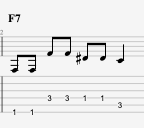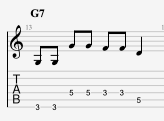I'm Tore Down Guitar Lesson (Freddie King, Eric Clapton)
A little while ago I learned a new word:
“Floccinaucinihilipilification.”
It’s basically, the act or habit of estimating something as worthless.
I’ve noticed a lot of intermediate guitar players often view simple blues progressions as being this.
They scoff, “ah huh huh, 3 chords?...simple shuffle?…”
Then dismiss it.
Well, don’t fall for this floccinaucinihilipilification trap.
Mastering the blues is essential to becoming a REAL player.
I’ve learned this from being around legends like Kenny Burrell and some of the greatest LA studio guitar players.
That’s why I don’t stop practicing simple blues progressions
In the quest to become a blues guitar master, there are many tunes we have to learn.
Today I’d like to share with you a fun song that is a must-know blues guitar classic.
It’s perfect for jamming with friends or with a looper pedal at home.
It was originally recorded by Freddie King, but in this post, we’ll talk about Freddie’s version and also Eric Clapton’s.
So grab your guitar and let’s dive into this “I’m Tore Down” guitar lesson.
Who wrote I’m Tore Down?
"I'm Tore Down" is a blues song with a rich history and multiple versions depending on your reference point. The original version, released in 1961, is credited to Freddie King (then known as "Freddy" King), although pianist Sonny Thompson played on several early King songs and is sometimes mentioned as a potential co-writer. It was recorded for Federal Records at their Nashville studio in 1961.
“I’m Tore Down” was first released as a single in 1961, with "Sen-Sa-Shun" as the B-side. It was produced by Jim Stewart. Backed by The Blue Devils, featuring Bobby Bland on piano.
The track reached number five on Billboard's Hot R&B Sides chart in 1961.
Eric Clapton also has a famous cover of this song which we will discuss as well. In 1994, Eric Clapton released his cover of "I'm Tore Down" on his blues tribute album From the Cradle.
This version stayed close to King's original arrangement and achieved further acclaim.
Over the years, the song has been covered by numerous artists, including John Hammond, Alexis Korner, Barrelhouse, and Blues Traveler.
"I'm Tore Down" remains a must-know blues standard, showcasing Freddie King's raw vocal power and expressive guitar playing.
I'm Tore Down Chords
“I’m Tore Down” follows a standard 12-bar blues chord progression. Freddie King’s version is in the key of D. While Clapton’s version is a whole step lower in the key of C.
The progression uses the I, IV, and V chords. So you’ll only need to know 3 chords to play either version. Then just shift the key depending upon which version you want to play.
Let’s start with Freddie King’s version. In the key of D major the I, IV, and V chords are going to be D, G, and A. But in a blues, I would typically play those chords as dominant seventh chords.
A dominant seven chord is considered one of the most important and versatile chords in Western music. It consists of four notes: the root, major third, perfect fifth, and minor seventh.
For example, in a D7 chord you would have these notes:
- Root: D
- Major Third: F#
- Perfect Fifth: A
- Minor Seventh: C
This chord shape can be played like this:

Then the G7 (IV chord) can be played like this:

And finally, the A7 (V chord) can be played like this:

When you see all dominant seventh chords like this in a progression it is often a dead giveaway that you’re playing a blues.
Let’s next take these same 3 chords and drop them down one whole step to the key of C. As I mentioned Freddie King plays “I’m Tore Down” in D while Clapton’s version is in the key of C.
Clapton’s key is slightly lower. This is done all the time by many famous musicians. The goal is to match the key to best fit the singer’s vocal range. Every singer is different and has different vocal qualities. The final objective is to put the song in the sweet spot of each singer’s vocal register.
So to do this for Clapton, we’ll take those 3 chords D7, G7, and A7, and move each one down a whole step or 2 frets. This is going to get you the chords C7, F7 and G7.
For C7 I would play this:

F7 can be played as a bar chord in the first position like this:

Finally, G7 can be played the same way as we did in the Freddie King version above like this:

Note that there is one chord (G7) in common between these two keys.
What key is I'm Tore Down in?
“I’m Tore Down” as recorded by Freddie King is in the key of D major. It uses the I, IV, and V chords (D7, G7, and A7) and follows a standard 12-bar blues chord progression throughout the whole song. The Eric Clapton version of “I’m Tore Down” is a whole-step lower and is played in the key of C using the chords C7, F7, and G7.
Freddie King's Guitar and Sound
Freddie King's signature sound was a fiery blend of blues, rock, and soulful vocals. He is most often seen with Gibson guitars.
He used a Gibson Les Paul Goldtop. This iconic guitar, featured on the cover of Let's Hide Away and Dance Away, became synonymous with King's image and sound
Later he embraced semi-hollow body guitars like ES-345s and 355s for their warmer tone and sustain.
He was known for playing Fender amps like the Fender Super Reverb and Fender Dual Showman.
Another key factor in his sound was his unorthodox playing style. He uniquely combined a thumb pick and metal fingerpick, emphasizing single-note articulation and this gave him a biting tone.
Remember, the magic of King's sound wasn't solely born from equipment. It was his passion, technique, and soul poured into every note that truly transcended mere gear and resonated with generations of musicians and fans.
I'm Tore Down Rhythm Guitar
“I’m Tore Down” uses a type of rhythm part I call “playing from a box pattern”. You can think of this as coming out of either your pentatonic box pattern or also just a dominant seventh chord shape.
Here is an example of how Freddie King and Eric Clapton both do this on their versions.

This would be played in place of the I chord in the key of C. It’s essentially a bassline on guitar. You start on the root note, then up the octave. Then you work your way back down the pentatonic or blues scale “box”.
This can then be moved around the neck for the other chords in a blues. So for example here is the same pattern over an F7 chord:

If you applied this over the V chord (G7) it would look like this:

So it’s the same pattern just shifted to different areas on the neck.
For more info on learning these scales and patterns grab my free blues scale guide below 👇
Let’s look more at the pentatonic or blues scale boxes this comes out of next.
I'm Tore Down Eric Clapton (Lead)
The primary scale used to solo over this song would be the minor blues scale. If you are playing the Freddie King version you would use the D minor blues scale. If you are playing the Clapton version use the C minor blues scale.
Let’s take a look at how Clapton does this. The first “box” pattern to learn is this one:

The core of the C minor blues scale is the C minor pentatonic scale (C Eb F G Bb). However, all you have to do is add one note, the flat 5. Here are the notes for the C minor blues scale:
- C (root)
- Eb (flat 3)
- F (4)
- F# (flat 5, aka "blue note")
- G (5)
- Bb (flat 7)
Clapton then takes these notes and arranges them into killer bluesy melodies and solos over the progression. Here is an example phrase of how he might do this:

Conclusion
At the end of the day, "I'm Tore Down" is a blues classic filled with raw emotion, expressive guitar work, and iconic chord progressions.
In this post, we've explored the history of this tune and dissected the differences between Freddie King's original and Eric Clapton's iconic cover.
Simply learning these rhythm and lead guitar parts will help you further understand playing the blues and be able to start jamming and improvising in your own way.
Keep practicing. And for more great blues guitar lessons check out this post on the 101 Best Blues Songs To Learn On Guitar next!
Like this blog post? Get Jon’s best guitar lessons straight to your inbox.
